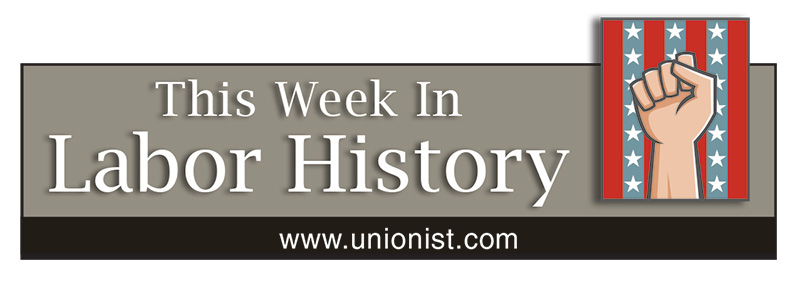This week in labor history: July 19-25


JULY 19
1848 – Women’s Rights Convention opens in Seneca Falls, N.Y. Delegates adopt a Declaration of Women’s Rights and call for women’s suffrage.
1940 – An amendment to the 1939 Hatch Act, a federal law whose main provision prohibits federal employees from engaging in partisan political activity, is amended to also cover state and local employees whose salaries include any federal funds.
JULY 20
1899 – New York City newsboys, many so poor that they were sleeping in the streets, begin a two-week strike. Several rallies drew more than 5,000 newsboys, complete with charismatic speeches by strike leader Kid Blink, who was blind in one eye. The boys had to pay publishers up front for the newspapers; they were successful in forcing the publishers to buy back unsold papers.
1934 – Two killed, 67 wounded in “Bloody Friday” Minneapolis truckers’ strike.
1971 – Postal unions, Postal Service sign first labor contract in the history of the federal government — the year following an unauthorized strike by 200,000 postal workers.
JULY 21
1877 – Local militiamen are called out against striking railroad workers in Pittsburgh. The head of the Pennsylvania Railroad advises giving the strikers “a rifle diet for a few days and see how they like that kind of bread.”
1880 – Compressed air explosion kills 20 workers constructing railroad tunnel under the Hudson River.
1964 – IWW leads a strike at Hodgeman’s Blueberry Farm in Grand Junction, Mich.
1926 – Radio station WCFL, owned and operated by the Chicago Federation of Labor, takes to the airwaves with two hours of music. The first and only Labor-owned radio station in the country, WCFL was sold in 1979.
1984 – A die-cast operator in Jackson, Mich., is pinned by a hydraulic Unimate robot, dies five days later. Incident is the first documented case in the U.S. of a robot killing a human.
JULY 22
1886 – Newly unionized brewery workers in San Francisco, mostly German socialists, declare victory after the city’s breweries give in to their demands for free beer, a closed shop, freedom to live anywhere (they had typically been required to live in the breweries), a 10-hour day, six-day work week, and a board of arbitration.
1916 – A bomb was set off during a “Preparedness Day” parade in San Francisco, killing 10 and injuring 40 more. Tom Mooney, a labor organizer, and Warren Billings, a shoe worker, were convicted of the crime, but both were pardoned 23 years later.
JULY 23
1892 – Anarchist Alexander Berkman shoots and stabs but fails to kill steel magnate Henry Clay Frick in an effort to avenge the Homestead massacre 18 days earlier, in which nine strikers were killed. Berkman also tried to use what was, in effect, a suicide bomb, but it didn’t detonate.
1913 – Northern Michigan copper miners strike for union recognition, higher wages and a eight-hour work day. By the time they threw in the towel the following April, 100 had been arrested on various charges and Western Federation of Miners President Charles Moyer had been shot, beaten and forced out of town.
1981 – Aluminum Workers Int’l Union merges with The United Brick & Clay Workers of America to form Aluminum, Brick & Clay Workers.
JULY 24
1968 – The United Auto Workers and the Teamsters form the Alliance for Labor Action (ALA), later to be joined by several smaller unions. The ALA’s agenda included support of the Civil Rights movement and opposition to the war in Vietnam. It disbanded after four years following the death of UAW President Walter Reuther.
2008 – The U.S. minimum wage is increased to $6.55 per hour. The original minimum, set in 1938 by the Fair Labor Standards Act, was 25 cents per hour.
2009 – U.S. minimum wage rises to $7.25 per hour, up from $6.55. The federal minimum wage has not increased since.
JULY 25
1877 – Workers stage a general strike — believed to be the nation’s first — in St. Louis, in support of striking railroad workers. The successful strike was ended when some 3,000 federal troops and 5,000 deputized special police killed at least 18 people in skirmishes around the city.
1890 – New York garment workers win closed shop and firing of scabs after seven-month strike.
1937 – Fifteen “living dead women” testify before the Illinois Industrial Commission. They were “Radium Girls,” women who died prematurely after working at clock and watch factories, where they were told to wet small paintbrushes in their mouths so they could dip them in radium to paint dials. A Geiger counter passed over graves in a cemetery near Ottawa, Ill. still registers the presence of radium.
2005 – The Teamsters and Service Employees unions break from the AFL-CIO during the federation’s 50th convention to begin the Change to Win coalition, ultimately comprised of seven unions (four by 2011: SEIU, Teamsters, UFCW and the UFW). They say they want more emphasis on organizing and less on electoral politics.
(Compiled by David Prosten, founder of Union Communication Services)

Leave a Reply